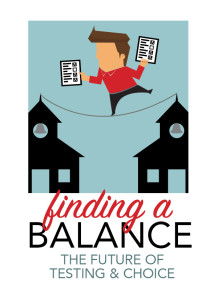Note: This is the third installment in our guest series on testing and parental choice. See the first contribution here and the second here. Coming Friday: Parent and charter school leader Jane Watt.
by Michael J. Petrilli
If every school in America was pretty good — if not better — our education policy debates would largely evaporate. Politicians would feel comfortable leaving educators alone to do their thing. And they would empower parents with the ability to choose the good (or great) school that best fit their values and their children’s needs.
 And in fact, that’s how we should treat the vast majority of schools today — district, charter, and private. Do they keep kids safe? Check. Can they demonstrate reasonable evidence that they are putting young people on a pathway to success in what comes next (postsecondary education, the workplace, and citizenship, especially)? Check. Fantastic! Parents, take your pick, and send the taxpayers the bill.
And in fact, that’s how we should treat the vast majority of schools today — district, charter, and private. Do they keep kids safe? Check. Can they demonstrate reasonable evidence that they are putting young people on a pathway to success in what comes next (postsecondary education, the workplace, and citizenship, especially)? Check. Fantastic! Parents, take your pick, and send the taxpayers the bill.
All the talk of backlash, opt-outs, and teachers quitting in despair would simply melt away, because both parents and educators would feel in charge again. No more micromanagement from Tallahassee or Washington. No more second-guessing decisions made on the ground. No more desperation at feeling pressured to narrow the curriculum, teach to the test, or follow bureaucratic dictates. Free at last, free at last! Thank God Almighty, we’d be free at last!
If I were king, that’s exactly how our system would work for the vast majority of schools. Every five or ten years, I’d ask them for reasonable evidence that they are one, safe and two, putting their students on a pathway to success. Meanwhile, I’d publish comparable information for parents to help them make good decisions for their children, including test-score data but other indicators too. Otherwise, I’d leave schools alone. I’d throw out the rule book — no class-size mandates, no teacher evaluation requirements, nothing.
Sound good?
Here’s the one problem: not all our schools are good or great. Some are downright God-awful. They might be safe, but they aren’t putting their students on a pathway to success. Their students hardly know more in June than they knew in September. Their teachers are ill-trained, ill-equipped, and outmatched. And yet they live on, zombie-like, in the district, charter, and private school sectors. They are the payday lenders of the education system, preying mostly on low-income parents who either don’t have a choice, or, for a variety of reasons, are making bad decisions with the choices they’ve got. These schools are serving neither parents’ interests nor the public good.
If I were king, I would simply shut these schools down. That’s not such a fanciful notion; in both New Orleans and Washington, D.C. that now happens regularly to bad charter schools, without much fanfare or resistance. That’s because the criteria are clear and sensible, the processes are fair and open, and because there’s a mechanism (chartering) to create new, good schools in their place. So it should be elsewhere, and in the district and voucher sectors too.
***
Here’s the point: Policymakers in Washington, in Tallahassee, and in state capitals nationwide should stop trying to micromanage the vast majority of schools. Just as regulators should mostly leave banks alone as long as their deposits are safe, so too should they leave schools alone as long as the kids are safe, the parents are happy, and the long-term outcomes look good. We should stop obsessing over “accountability” and instead focus on “transparency” — thoughtful indicators of school quality that are delivered to parents and educators in a timely manner, to help with school-choice decisions and school-improvement processes.
But on the flip side, policymakers should be much more aggressive about shutting down failed schools in any sector, or kicking schools out of voucher programs if their students aren’t making meaningful progress. And they need an effective mechanism to create good new schools in their place.
For sure, this approach won’t address all of our problems. It won’t force schools to go from “good to great.” It won’t address the very real concern that even our best schools are getting mediocre results in international comparisons. And it won’t solve the dilemma of how to better serve our highest-achieving students.
Yet, in my view, no set of state or federal policies can achieve such ambitious ends. We need more humility about what policy can accomplish—and we need more faith in parents and educators to solve these problems and balance the very real trade-offs in play, in their own schools, and in their own communities.
With bad schools, we should go to town and shut them down. And with the rest, we should trust but verify. With heavy emphasis on the “trust.”